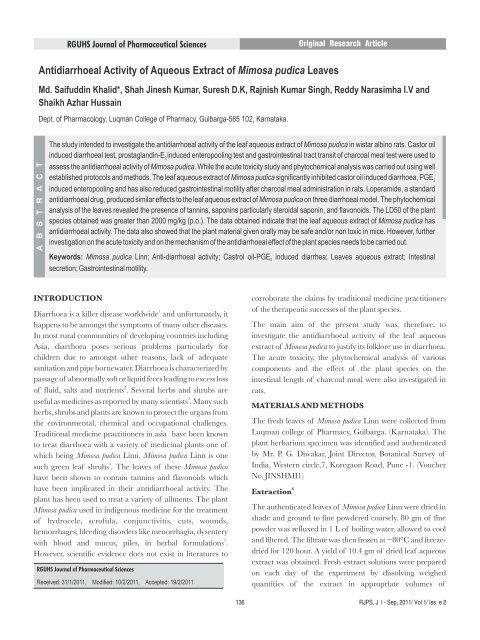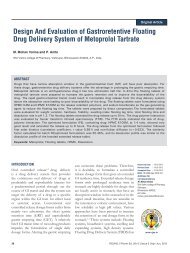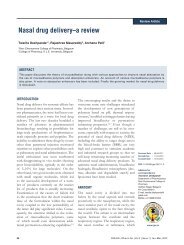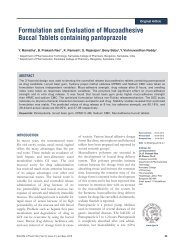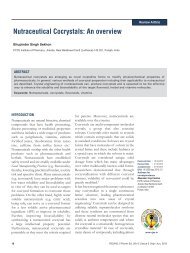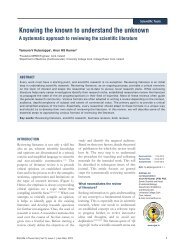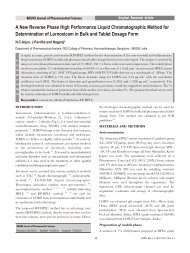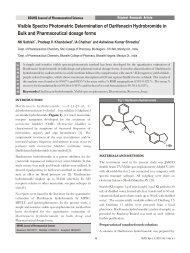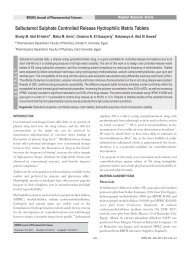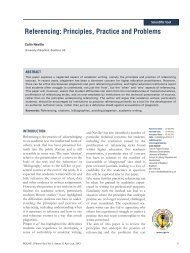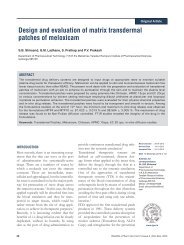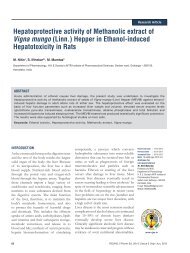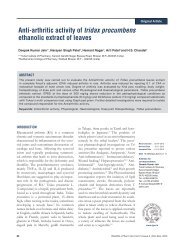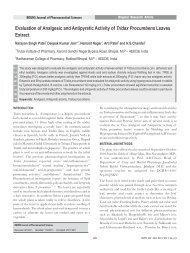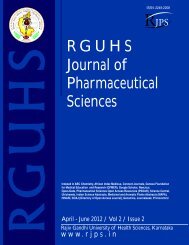Chitosan Loaded Mucoadhesive Microspheres of Gliclazide - Journal
Chitosan Loaded Mucoadhesive Microspheres of Gliclazide - Journal
Chitosan Loaded Mucoadhesive Microspheres of Gliclazide - Journal
Create successful ePaper yourself
Turn your PDF publications into a flip-book with our unique Google optimized e-Paper software.
RGUHS <strong>Journal</strong> <strong>of</strong> Pharmaceutical Sciences<br />
Antidiarrhoeal Activity <strong>of</strong> Aqueous Extract <strong>of</strong> Mimosa pudica Leaves<br />
Md. Saifuddin Khalid*, Shah Jinesh Kumar, Suresh D.K, Rajnish Kumar Singh, Reddy Narasimha I.V and<br />
Shaikh Azhar Hussain<br />
A B S T R A C T<br />
Dept. <strong>of</strong> Pharmacology, Luqman College <strong>of</strong> Pharmacy, Gulbarga-585 102, Karnataka.<br />
INTRODUCTION<br />
1<br />
Diarrhoea is a killer disease worldwide and unfortunately, it<br />
happens to be amongst the symptoms <strong>of</strong> many other diseases.<br />
In most rural communities <strong>of</strong> developing countries including<br />
Asia, diarrhoea poses serious problems particularly for<br />
children due to amongst other reasons, lack <strong>of</strong> adequate<br />
sanitation and pipe bornewater. Diarrhoea is characterized by<br />
passage <strong>of</strong> abnormally s<strong>of</strong>t or liquid feces leading to excess loss<br />
2<br />
<strong>of</strong> fluid, salts and nutrients . Several herbs and shrubs are<br />
3<br />
useful as medicines as reported by many scientists . Many such<br />
herbs, shrubs and plants are known to protect the organs from<br />
the environmental, chemical and occupational challenges.<br />
Traditional medicine practitioners in asia have been known<br />
to treat diarrhoea with a variety <strong>of</strong> medicinal plants one <strong>of</strong><br />
which being Mimosa pudica Linn. Mimosa pudica Linn is one<br />
4<br />
such green leaf shrubs . The leaves <strong>of</strong> these Mimosa pudica<br />
have been shown to contain tannins and flavonoids which<br />
have been implicated in their antidiarrhoeal activity. The<br />
plant has been used to treat a variety <strong>of</strong> ailments. The plant<br />
Mimosa pudica used in indigenous medicine for the treatment<br />
<strong>of</strong> hydrocele, scr<strong>of</strong>ula, conjunctivitis, cuts, wounds,<br />
hemorrhages, bleeding disorders like menorrhagia, dysentery<br />
5<br />
with blood and mucus, piles, in herbal formulations .<br />
However, scientific evidence does not exist in literatures to<br />
Original Research Article<br />
The study intended to investigate the antidiarrhoeal activity <strong>of</strong> the leaf aqueous extract <strong>of</strong> Mimosa pudica in wistar albino rats. Castor oil<br />
induced diarrhoeal test, prostaglandin-E induced enteropooling test and gastrointestinal tract transit <strong>of</strong> charcoal meal test were used to<br />
2<br />
assess the antidiarrhoeal activity <strong>of</strong> Mimosa pudica. While the acute toxicity study and phytochemical analysis was carried out using well<br />
established protocols and methods. The leaf aqueous extract <strong>of</strong> Mimosa pudica significantly inhibited castor oil induced diarrhoea, PGE<br />
2<br />
induced enteropooling and has also reduced gastrointestinal motility after charcoal meal administration in rats. Loperamide, a standard<br />
antidiarrhoeal drug, produced similar effects to the leaf aqueous extract <strong>of</strong> Mimosa pudica on three diarrhoeal model. The phytochemical<br />
analysis <strong>of</strong> the leaves revealed the presence <strong>of</strong> tannins, saponins particularly steroidal saponin, and flavonoids. The LD50 <strong>of</strong> the plant<br />
species obtained was greater than 2000 mg/kg (p.o.). The data obtained indicate that the leaf aqueous extract <strong>of</strong> Mimosa pudica has<br />
antidiarrhoeal activity. The data also showed that the plant material given orally may be safe and/or non toxic in mice. However, further<br />
investigation on the acute toxicity and on the mechanism <strong>of</strong> the antidiarrhoeal effect <strong>of</strong> the plant species needs to be carried out.<br />
Keywords: Mimosa pudica Linn; Anti-diarrhoeal activity; Castrol oil-PGE induced diarrhea; Leaves aqueous extract; Intestinal<br />
2<br />
secretion; Gastrointestinal motility.<br />
RGUHS <strong>Journal</strong> <strong>of</strong> Pharmaceutical Sciences<br />
Received: 31/1/2011, Modified: 10/2/2011, Accepted: 19/2/2011<br />
136<br />
corroborate the claims by traditional medicine practitioners<br />
<strong>of</strong> the therapeutic successes <strong>of</strong> the plant species.<br />
The main aim <strong>of</strong> the present study was, therefore, to<br />
investigate the antidiarrhoeal activity <strong>of</strong> the leaf aqueous<br />
extract <strong>of</strong> Mimosa pudica to justify its folklore use in diarrhoea.<br />
The acute toxicity, the phytochemical analysis <strong>of</strong> various<br />
components and the effect <strong>of</strong> the plant species on the<br />
intestinal length <strong>of</strong> charcoal meal were also investigated in<br />
rats.<br />
MATERIALS AND METHODS<br />
The fresh leaves <strong>of</strong> Mimosa pudica Linn were collected from<br />
Luqman college <strong>of</strong> Pharmacy, Gulbarga. (Karnataka). The<br />
plant herbarium specimen was identified and authenticated<br />
by Mr. P. G. Diwakar, Joint Director, Botanical Survey <strong>of</strong><br />
India, Western circle,7, Koregaon Road, Pune -1. (Voucher<br />
No. JINSHMI1)<br />
6<br />
Extraction<br />
The authenticated leaves <strong>of</strong> Mimosa pudica Linn were dried in<br />
shade and ground to fine powdered coarsely. 80 gm <strong>of</strong> fine<br />
powder was refluxed in 1 L <strong>of</strong> boiling water, allowed to cool<br />
and filtered. The filtrate was then frozen at −80°C and freezedried<br />
for 120 hour. A yield <strong>of</strong> 10.4 gm <strong>of</strong> dried leaf aqueous<br />
extract was obtained. Fresh extract solutions were prepared<br />
on each day <strong>of</strong> the experiment by dissolving weighed<br />
quantities <strong>of</strong> the extract in appropriate volumes <strong>of</strong><br />
RJPS, Jul - Sep, 2011/ Vol 1/ Issue 2


